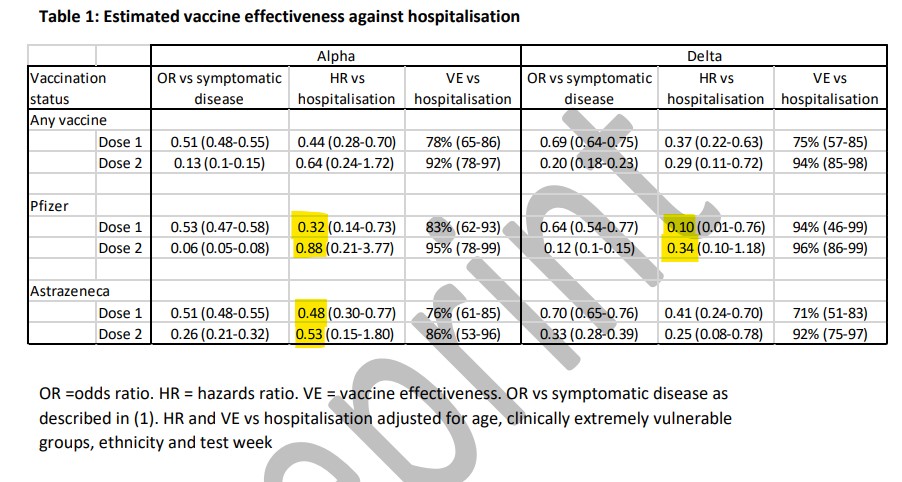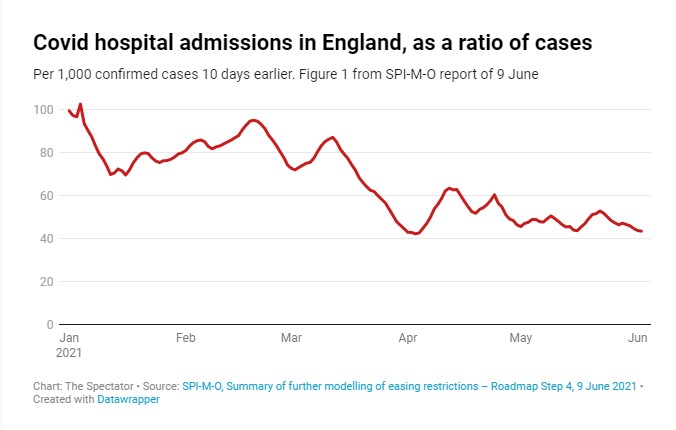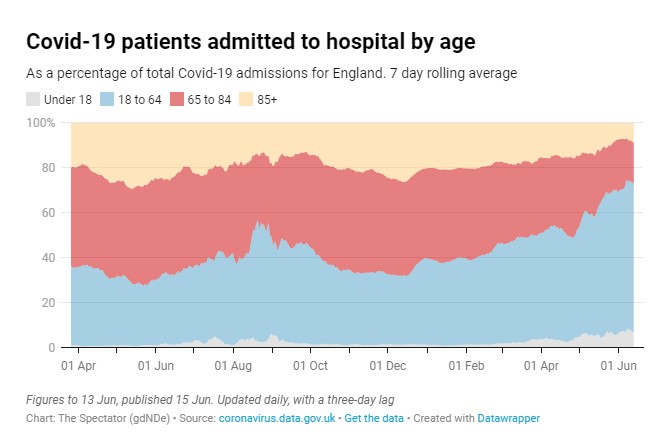It’s not two weeks since Lockdown Sceptics was casting doubt on Public Health England’s alarming claim that the Delta (Indian) variant had more than double the risk of hospitalisation of the Alpha (British) variant. How long will they take to backtrack after the panic has done its damage, we asked?
Well, it turns out that even before Boris took to the podium on Monday PHE had already released a new study claiming that vaccines after all are more effective at preventing hospitalisation against the Delta variant than the Alpha variant. Here’s the story in the Telegraph:
Vaccines are more effective at preventing hospitalisation against the Indian/delta variant than they were against previous types, once people are double-jabbed, new data shows.
Real world data shows the Pfizer/BioNTech vaccine is 94% effective against hospital admission from the variant after one dose, rising to 96% after two jabs.
The Oxford/AstraZeneca vaccine was found to be 71% effective against hospital admission after one dose, rising to 92% after two jabs.
In both cases, two doses had a greater impact preventing hospitalisations than was the case with the Kent variant.
The new study and the earlier study aren’t quite showing the same thing. The earlier study showed the risk of hospitalisation with the Delta versus Alpha variant for all those testing positive, not just the vaccinated, though subsequently adjusted the results for “vaccination status”. The new study specifically looks at the hospitalisation risk in those vaccinated with respect to the Alpha and Delta variants and compares them. However, the two studies should come to broadly the same conclusion, as they are both looking at how much more serious disease is with the Delta variant. At any rate, given that a large proportion of the vulnerable population is now fully vaccinated, we certainly shouldn’t see a doubling in the hospitalisation rate with the Delta variant if, as is claimed in the new study, the vaccines are better at preventing serious disease from that variant.
Ross Clark suggests the problem with the earlier data was that the sample size was small and biased. As he notes, PHE’s modelling misses the most obvious data point, that the rate of hospitalisations per case has not increased as the Indian variant has become dominant (see graph below). How then can the Indian variant have twice the risk of hospitalisation?
Is the new study any more reliable than the earlier one? As usual with a PHE observational study, it’s hard to tell, as much of the method is hidden behind opaque statistical techniques with working that is not set out. All the reader knows is that raw data is taken and transformed by some statistical process into hazard ratios and vaccine effectiveness estimates that are all but impossibly to verify. What we can do, though, is look at the results of this largely concealed data-processing and see if it makes sense.
Below is the table from the study (there’s only one, it’s a very short paper), and it shows something very curious.

It shows that, once testing positive with the Alpha variant, one dose of Pfizer reduces the risk of hospitalisation by 68% (the 0.32 highlighted), but the second dose only reduces the risk by 12%! That’s 12% in total (the 0.88 highlighted), not 12% on top of the 68%. So the second dose significantly increases your risk of being hospitalised compared to the first dose? That can’t be right. But it’s what it says.
The same thing happens with AstraZeneca against the Alpha variant: the first dose reduces the hospitalisation risk by 52% (the 0.48 highlighted) but the second dose only by 47% (the 0.53). And again with Pfizer against the Delta variant: the first dose reduces hospitalisation risk by 90% (the 0.10), the second dose only by 66% (the 0.34). The only combination where the risk-reductions are the right way round is AstraZeneca against the Delta variant: one dose reduces the risk by 59% (the 0.41 not highlighted under the 0.34) but two doses reduces it by 75% (the 0.25 beneath).
The gaping confidence intervals (0.21-3.77; 0.15-1.80; 0.10-1.18; 0.08-0.78) are also giveaways of a lack of reliability in the findings. For instance, the Pfizer dose-2-against-Alpha confidence interval of 0.21-3.77 means the authors are 95% sure the hospitalisation risk lies somewhere between a reduction of 79% and an increase of 277%! That’s basically meaningless.
How did the authors avoid these blatant red flags in their data and modelling (the hazard ratios are a modelled value) showing up in the headline figures? By keeping the report very short, not discussing the limitations of the study, and only converting to a percentage value (which is readily understood by many people) the overall vaccine effectiveness against hospitalisation (i.e., the risk of hospitalisation-once-infected multiplied by the risk of being infected), while leaving the dubious hospitalisation hazard ratios as an obscure decimal. It seems to have worked: journalists have dutifully reported the headline vaccine effectiveness figures but not queried the strange hazard ratios behind them.
A separate study from Scotland, published as a research letter in the Lancet and reported alongside the PHE study in many places, claims to find the vaccines are a bit less effective against the Delta variant. But it too is heavily adjusted, its positivity figures are all over the place (e.g. the Delta-variant test-positivity for AstraZeneca 13 days after the second dose is nine times as high as for Pfizer) and the confidence intervals again are huge, suggesting a small sample with low confidence.
Despite these problems with both studies, I do think the vaccines probably are effective against serious disease to some degree. (Safety is a separate matter.) The reduction in the proportion of Covid hospital admissions in the over 65s in the past few months (see graph below) is perhaps the most striking data point on this. This fits with the detection of antibodies in the blood post-vaccination – if the disease progresses to a systemic stage then the body has additional antibodies to fight it.
I’m less convinced at the moment on how effective the vaccines are against infection and transmission. Almost all the studies on this are confounded by declining background incidence (among other problems). Also, we know the vaccines do not produce mucosal (IgA) antibodies, which have been shown to dominate the early response to SARS-CoV-2. This suggests the defence they offer against infection and mild disease may be less robust. Places with high vaccination rates and high case rates such as Seychelles, Maldives, Bahrain and Chile also suggest the protection against infection may be limited. But perhaps more data and new studies will alter that picture – I’m certainly on the lookout. They’ll have to do better than PHE, though.














To join in with the discussion please make a donation to The Daily Sceptic.
Profanity and abuse will be removed and may lead to a permanent ban.
550 mile range in my diesel Audi.
5 mins to fill it.
Heater on, fast as a like.
Plants get free CO2 to eat too.
Plus 12 year black kid in the Congo didn’t have to go down a mine to get the stuff that makes the silly EV work
850 on a tankful in my Renault Trafic. Heater or a/c full on
450+ in my little Hyundai i10 .. with heater, lights and radio on. £30 pa road tax; cheap to insure.
EVs are simply not a practical idea for long-distance driving. But perhaps that’s the whole point. They want us either not to travel far, or to use public transport and ditch private vehicles altogether. Remember the old prediction that people will own nothing, and be happy.
And the most galling thing is that all this inconvenience isn’t going to have the slightest beneficial effect on the climate.
Just like the attacks on Farmers harvest (pun intended) very little. This seems to be part of the Agenda 2030 push to Build Back better.
Or ‘Extract Money Faster’
“EVs are simply not a practical idea..”
You could have stopped there. If they were we would have been driving them for decades instead of ICEVs.
And you wouldn’t need to subsidise them with taxpayers cash or use taxpayers money to provide charging points.
Recall of MPs Act 2015:https://notonthebeeb.co.uk/so/c8PDZE4U1?languageTag=en&cid=426765f9-8b6f-43e7-9ca1-b318db924f5c
£1.12 per kWh is a rip off, if you convert the thermal content of petrol at roughly 9 kWh per litre & guesstimate the efficiency of your engine at around 30%. It’s like paying out £3.50 a litre.
Incidentally, at todays prices my petrol car averages about 9p per mille, with most fuel being bought from ASDA – and a lot of the total is longish M road trips.
The whole “Green Energy” thing is a rip-off. Pay more and get less. (If it’s available, that is. And with unreliables such as wind and solar, that’s not guaranteed.)
The huge question is will TPTB allow us to continue to nurse our ICE cars for as long as we can manage? Or will there be a huge bunch of taxes, ULEZ schemes and restrictions on spare parts so as to ‘drive’ us off the road?
If we are allowed to keep them going? I think there will be a big industry in keeping old ICE cars on the road. But if they force the issue and make it EVs or nothing then it is a dismal outlook. I suspect that new technologies will come along for transportation but the current generation of EVs will spell the end of happy family leisure motoring. At best us hoi-polloi may have a cheap low range Chinese EV for local utility travel.
I’m sure the easiest thing for TPTB would be to target fuel supplies. If they can find a way to stop us getting supplies of petrol and diesel, then it’s basically game over for the ICE vehicle.
And there was me thinking the Government are there to facilitate the will of the electorate!
Oh no, it’s there to shape the nation according to its own will. But first it has to hoodwink enough of the electorate into thinking that they both have the same interests.
What a quaint notion!
Let’s face it – if you remove personal transport then the leisure industry is dead. Unemployment, no tax income follows. Think of all the places that are not reachable by public transport. Think of all those who support motor vehicles who will now be unemployed. The hit to the government finances would make Rachel from Account’s imaginary black hole real by many times more.
Mileage with the heating off is not the proper mileage though. It is like saying my plate of steak and chips will fill me up but only if I eat 3 Kitkats first.
The British writer Patrick Hamiltion wrote about the horror of the motorcar. He is almost completely forgotten these days but his novels are well worth reading. Hangover Square, The Slaves of Solitude. He lives on though in one sense and that is through a play he wrote called Gas Light. There was a good Ingrid Bergman film of it. This term has found its way into modern political discourse, gaslighting, although its meaning has been distorted slightly.
One thing I like about the Brits, the common people, is that they never get all enthusiastic about a new technology like the Yanks do. They might adpot it eventually, usually out of laziness and vacantness but there isn’t any expectation that all of this crap could ever make life better. Although I have read horrible stories in educational supplements about how teachers are applauding the fact that every child in their class has an electronic tablet. Basically a zombie machine and you hear that parent give phones to children as young as ten. This is horrific just slightly less horrific than the demoniac smiles of the Yanks selling this crap.
The number of mobile phones per capita far outreached that in the USA in the 1990s.
The cost per unit of electricity obviously varies depending on which type of tariff you’re on but is at least 40p/kwh so charging the author’s Ford at home would work out as about the same cost per mile as his Honda Civic. Therefore it would be impossible to recoup the massive extra cost of the Ford. Proof that EVs are only for the well off.
It would be interesting to compare the cost per mile of an EV versus a petrol or diesel for urban driving and see if the costs work out about the same as motorway driving. Driving at speed means far more air resistance hence higher energy use per mile but urban driving is often stop start. Accelerating uses far more energy than driving at a constant speed and a lot of this energy is lost when braking so driving in traffic may result in roughly the same energy use per mile as motorway driving.
The nail in the coffin is the cost of battery replacement.
It astounds me that anyone chooses to buy an EV – apart from company car drivers who have to get one and gain some tax advantages.
“if you regularly cover high mileage in an EV, you need to travel when everyone else isn’t to avoid queuing at chargers.”
Au contraire, I see all the BEVVERS travelling in groups. It’s so they have fellow BEVVERS to socialise with while they wait together for two hours to charge their BEVs not too quickly to avoid damaging the batteries. They also get to share enlightening, heartwarming stories about how well they are saving the planet. And they MUST be friends, because fighting over chargers isn’t a very planet friendly look. Too much CO2 is emitted when you fight.
A bevvy of electric car drivers.
“Every cloud has a silver lining though. Your correspondent predicts an impending boomtime for old style garages and the market in spare parts for petrol cars for years to come.”
The Government will simply outlaw cars over a certain age, 12 years perhaps, and maybe make it illegal to sell spares apart from brake pads – all with no reference to Parliament of course.
Drugs are illegal but people get very rich selling them without too much problem.
”To eke out the range I travel everywhere with the heater off, which currently demands a substantial coat, hat and gloves.”
Yes prior to the 1970s cars required that, and many afterwards too for a number of years.
I do so love technological progress.
James May a few years back showed that the range of battery cars had barely increased since the 1890s. Yes, they are more comfortable. Yes, they go much faster….for a short while.
That’s the funniest bit for me – EV’s are not new tech. Sure lithium ion cells and 0-60 times in a few seconds is newish (and pointless day to day), however the electric BEV is over 100 years old… and we ditched them for petrol and diesel powered vehicles… until governments started bribing people with subsidies and tax breaks to start buying them again